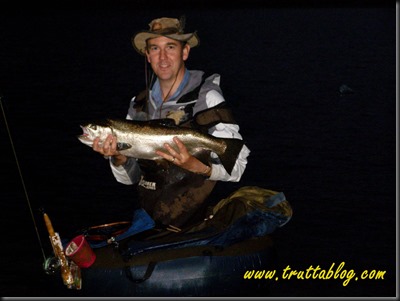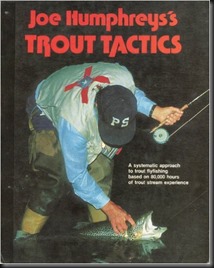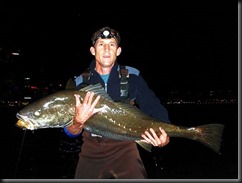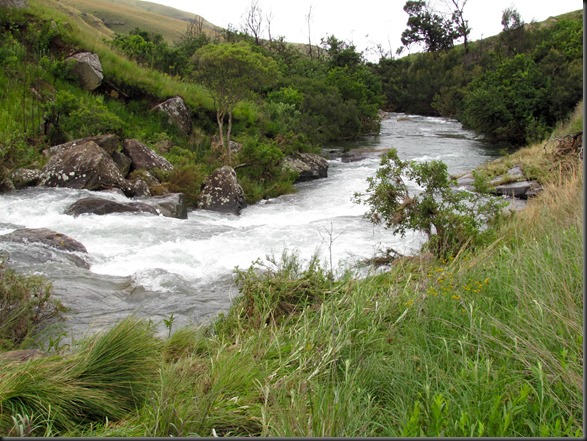Being one who mulls a lot (someone once labeled me a DTN*), I have been dabbling with the concept of night fishing. Mental dabbling that is. And I am talking here of night fishing in rivers ….not stillwaters.
I have done a bit of night fishing on stillwaters.
A bit.
Not enough.
But I confess, I have never truly night fished a stream.
My angling background is thick with images of people holding up fish in an inky blackness, or stories of Browns coming out in the dark, and of talk of fishing at night when it cools off. I remember the cover of Joe Humphries “Trout Tactics” with just such an image.
Then just this week, I saw these images of my friend Brett Coombes in Australia:
Somehow though, my buddies and I just haven’t joined the dots. I don’t know why. Maybe us South Africans associate night time with murder and evil. That would be silly…all that stuff happens here in broad daylight! Maybe we are just scared of the dark. Or maybe it is because we lack great big rivers with even gravel streambeds, which one can shuffle into without the benefit of sight. Our streams are small and tumbling, and back-casts could be difficult if performed by sound alone, not to mention finding footholds, or even getting down into the canyon in one piece.
For now, I am writing those off as weak excuses though. It’s time we did this thing. American media has been extolling the virtues of big streamers for monster browns at night for a long time, and somehow we have been ignoring it. We have long been reading about how big browns travel long distances at night on the hunt for food. We even have fly-tyers tying up big mouse imitations. I don’t know about you but stereotype images of a big mouse making a wake and being swallowed in the blackness of night, come quickly to mind. And maybe this thing is not as stereotyped as muslims with wires sticking out of their clothing and cheese in mousetraps, but for now I am going to treat it as the gospel truth until I have proved otherwise. Hell, I am a man of faith!
I put cheese in a mousetrap myself the other day. Graeme said I had been watching too many Tom & Jerry movies. Well this time I have been reading too many romatisized “Big Browns at night” stories, and I am going to put some cheese on that metaphoric mousetrap and go try the Mooi at the bewitching hour. PD says he just needs to check that his medical aid and his life insurance are up to date, and he is IN!
The upper Mooi….a perfect spot for a stroll on a moonless night, wouldn’t you say?
* DTN apparently stands for “Deep Thinking Nigger”. Some of my friends actually call me that. Like my comment on Muslims and wires, this is used parochially and descriptively here with no racial or religious bias whatsoever. I might however, not make such innocent utterances when I am fumbling about stubbing my toes and getting washed downstream on a piece of water like that above, on a moonless night.






4 Responses
There’s a definite mystique to it. Go with a partner. Know the water. Keep the light away. And use a big fly. Once in a while it really works. Fine post!
Love your latest post, Andrew! Regards Sheena
Thank you Sheena.
Brett Coombes, who is pictured above with the huge Mulloway at night, sent me this very informative and entertaining reply to the post above:
Hi Andrew,
Some years back, my fishing friend Albert introduced me to night fishing for trout on one of our water catchment lakes down south. Logue Brook Dam (aka Lake Brockman) appears lifeless. I have never seen or caught a trout there during the day. The water is glassy clear and apparently devoid of any insect life. We arrived at the lake around sunset and scoped out a suitable spot where a small stream flowed into the lake. For an hour or so we chummed for Yabbies and Marron (local freshwater crayfish) using chicken pellets. Once the sun had gone down we fished well into the dark on a completely moonless night, throwing big black flies like Mrs Simpsons, Walkers Killers and Albert’s favourite Black Phantom. Using a slow retrieve on a floating line we were able to hook up with several trout until the caffeine wore off and we drove groggily back to Perth.
Albert and I did a NZ trip in May 2002. While we were pretty successful with our day time fishing, some of our best catches were at night well after sunset. By far the biggest fish we saw on that trip were caught at Flaxy Lake, which is a part lake, part stream. It’s essentially a small lake with water flowing strongly through it to a hydro system downstream. Two fishermen from Auckland arrived at the lake well after sunset. From there accents, it was clear they were both SA ex-pats. Fishing with a 2-fly setup, one black fly and one flouro bug, they caught and released three ‘bows of double figures, while we went fishless.
Night time Glo-bug fishing in the lakes around Rotoroa is a popular fishing method on North Island, and for good reason. These lakes are frighteningly clear and the fish will only venture into shallower water after dark when they congregate around stream mouths.
I honestly could not fish in the pitch dark every day because it is tiring and it requires one to keep odd hours that are not compatible with family, work and normal society. For 2 weeks a year, for fish this big, I’m happy to make an exception and cope with less sleep and difficulty concentrating at work!
Yes, the Kob were big. The largest was 17kg, or 38 pounds. We estimate their weights using a length-weight formula derived from a fisheries research paper that has documented WA’s Mulloway biology from a large sample of around 500 fish. Unlike trout, that have a condition factor and mass strongly influenced by their gender and the condition of the water they come from, Mulloway exhibit a very high correlation between weight and length, and age and length. A 1.25m long fish (usually a female) would be 12-15 years old and weigh 17kg (plus or minus 0.1% of the square root of 0!).
The Mulloway fought very well, albeit a bit doggedly toward the end, and all were released unharmed. When first hooked, mulloway will make a very hard run and are pretty much unstoppable if they decide to head back towards structure. Back in October 2006 and 2007, I got cleaned up by a couple of big fish that had a head of steam up and went down and deep under and over concrete and rocks. I have a half a fly line with a frayed end as a souvenir.
If you can stop their initial run and turn them towards open water, then they generally fight clean. They are able to pull a lot of backing, but once they are tired it’s just a matter of hanging on and using the strength of the tippet, rather than the rod, to gain line bit by bit.
Some of my friends have caught Mulloway on 8 and 9 weight rods. I try to even the odds with a heavier rod that can safely pull an 8 or 10kg tippet. I usually use a 10 weight stick, but I broke my favourite rod a couple of years ago, so I now have an 11 weight in the same make and range. There are obvious advantages to wielding a sturdier rod. The flies we are chucking for these big Mulloway are 5-6 inches long to mimic the size of the baitfish. Flies are fairly heavily dressed, have lead dumbbell eyes, some have a rattle tube tied into their bodies, and all are tied on biggish hooks – usually Gamakatsu in 4/0 or 6/0. The pic attached above shows some of my flies. The black one looks deadly in the water. The fluoro chartreuse flies bottom left seem to be the most effective. For scale, the backdrop is an A4 piece of paper, 30cm long.
I broke my 10 weight by hitting the tip section with a dumbbell-eyed fly. They are not easy flies to cast in the dark (downright dangerous with a tailwind!) and chucking them on a bigger rod and a shooting head setup makes the evening slightly more pleasant.
In the dark, this kind of blind fishing can be fairly boring, so being able to consistently throw a long line and deliver a big fly mechanically, cast after cast is imperative. The fishing “window” we are fishing to is a narrow run-in tide period. These fish are on their annual pre-spawning migration and are working their way up the Swan River from the sea in order to fatten up on Hardyheads and Bony Herring. By around late September, they can sometimes be up as far as Perth’s Narrows Bridge, which is where the river narrows to a shallow channel about 200m wide. The mid-October new moon high tides are ideal and produce adequate tidal movement (around 1m highs….Perth has very little tidal movement). The tidal inflow through the Narrows causes baitfish and Mulloway to converge. The Mulloway will generally lay low and lazy along the bridge pylons until the incoming tide starts to slacken. While wading on the sand flats around the bridges, I have seen Mulloway swimming out from the bridge around the top of the tide.
Some time in December the Mulloway turn around and head back down river to spawn. Most of them spawn out at sea near offshore reefs and drop-offs where the larvae can disperse with the currents. There is anecdotal evidence of spawning aggregations of Mulloway in the lower tidal reaches of the Swan River estuary in a deep channel where rocks and an old barge wreck act like a reef. It is thought that they spawn at the top of the high tide so the fertilised eggs are carried out to sea.
Now, about the torchlight. I use a bright L.E.D. head torch, which I use to light up some of my fluoro flies. And no, you definitely don’t want to shine torchlight anywhere near the water. I point my head torch upwards and cup my hand around the fly and torch to prevent light spill when lighting up a fly. Wading quietly and not talking is also a good idea. Mulloway hunt by sight and sound. Their eyes have tapetum lucidum and are very sensitive to light.
There are full moon high tides around midnight from tonight through to Friday, then new moon tides over 9 to 15 November. Sleepless nights are here again…..Thank god for strong coffee.
Cheers
Brett
Thank you Brett!